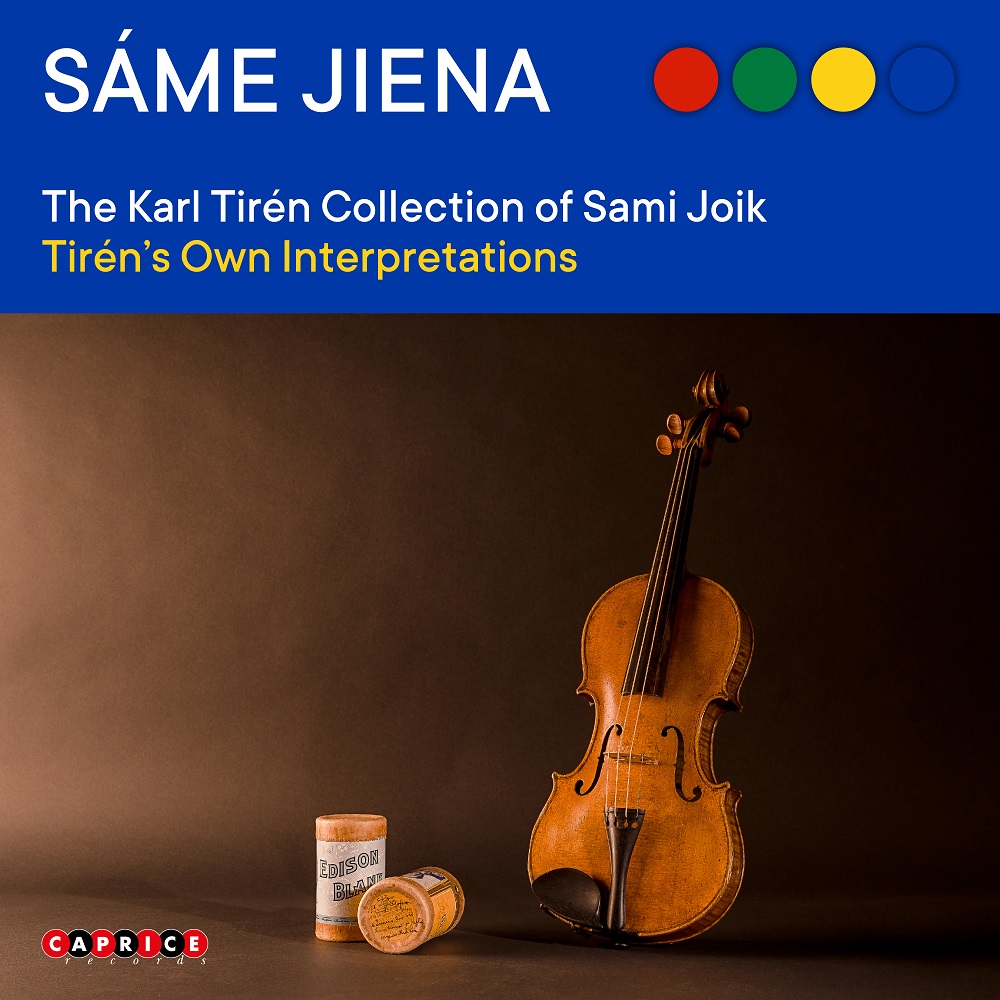SÁME JIENA – The Karl Tirén Collection of Sami Joik: Tirén’s Own Interpretations
Karl Tirén
This is the 6th volume of field recordings of Sami joik made in the 1910s. This last volume in the series is different from the previous installments, in that it contains recordings where Karl Tirén (1869-1955) performs his own interpretations of various Sami joiks, in his own characteristic way. Mostly, he uses the violin, but sometimes singing, or, when the range demands it, the viola. For the unaccustomed listener, this is a great opportunity to get an easier understanding of the basic melodic structure of the joiks, but the recordings also give some perspective around folk musical experimentation of the time and is a clear testament to Karl Tirén’s personal fascination and deep love for the Sami music and culture.
In the fall of 1912, musicologist, stationmaster, artist, and violin maker Karl Tirén was offered the loan of a phonograph and pertaining wax cylinders from the Swedish Museum of Natural History’s ethnographic department, with the instruction of recording Sami traditional singing (joik), storytelling and other verbal traditions. The apparatus itself was among the marvels of the modern age and had been purchased in Berlin just a few years prior. Acquiring Sami objects for the museum’s collection was also part of the ethnographic department’s mission.
Sami joik
The joik is a particular way of singing, which was developed by the Sami. Besides the voice technique, the main difference between joik and other types of songs in the Nordic region is the relation between the song as an aesthetic expression and its content.
Joiking a person or animal
Traditional joiks relate to what has been described as a reference object; this may be a person, an animal or a place. A performer does not joik about a particular person or animal, but rather joiks that person or animal, which is to say, giving them a musical formation in performance, influenced by the joiker’s perception and appreciation of their qualities.
These joik melodies are used by social groups so that the joiks become a form of musical name for the reference object, which many Sami can recognize and perform at different times. For example, during Karl Tirén’s recording sessions it sometimes occurred that when a new person came into the room, one of the present joikers would begin to perform the ‘personal joik’ of that individual, as a means of welcome and of confirming his or her relationship with them.
Musical characteristics
It is often possible to identify joik through its approach to the voice and timbre – often sung with what has been described as a “pressed” or “pinched” voice, and rich use of ornaments and glissandi between notes. When joik melodies are represented in musical notation, it is not unusual to see asymmetrical time signatures (for example, 5/8, 7/8 or 11/8), with the melodies often being cyclical, so that the performance may continue for as long as the joiker desires, or the situation allows.
The Swedish verb jojka is derived from the Sami juiogat. In Swedish, the act of joiking has increasingly come to be known as joik. Quite simply, you joik a joik. The Sámi terminology is rather different. In the Northern Sami language, one joiks a luohti (plural luoðit), in Lulesami, a vuolle (plural vuole) and in Southern Sami, a vuelie (plural vuelieh). For the performance of songs and hymns the terms lávla, singing, and lávlut, to sing, are used.
The first joik encounter
Karl Tirén’s first impression of the joik came via meeting Lars Erik Granström at the big Luleå fiddler competition in 1909. After that, Tirén was hooked – collecting, exploring and publicizing the Sami musical culture would accompany him for the rest of his life. Later that same year, Tirén met woodturner Maria Persson. She became his most important informant and guide in the Sami joik tradition, something very few had been privy to before.
The first recording trips, to the winter markets in Arvidsjaur and Arjeplog, were made in February 1913. In July that year, Tirén made a collecting journey which he started off by making more phonograph recordings, mostly in Tärnaby in conjunction with a so-called Prayer Day. He also chronicled several joiks onto paper by ear.
In January 1914, Tirén visited the winter markets in Lycksele and Åsele, continuing his recording work. The summer of 1914 resulted in recordings from a trip to Jokkmokk and Kvikkjokk in late June, as well as in July in connection to the governor Walter Murray’s meetings with reindeer keeper at various locations. Tirén’s last field recordings with the phonograph were made in October 1915, when he was invited as a guest to Maria Persson’s (afterward, Persson-Johansson) wedding.
Phonograph – the first recording technology
he phonograph was the first technology for recording, storing and reproducing sound. The device was invented by Thomas Edison in 1877 but only came into wider usage from the 1890s, due to the change from tinfoil to the wax cylinder as the audio carrier.
The phonograph is a purely mechanical technology that does not require electricity to operate. Compared to modern recording equipment, a phonograph has neither a microphone, amplifier or speakers. The wax cylinder is usually rotated in place by means of a clockwork spring.
Karl Tirén and the phonograph
Karl Tirén had learned to use a phonograph from Yngve Laurell at the Ethnographic Museum, who in turn had acquired the technology at the then world-leading research archive on folk music from around the world, the Berliner Phonogramm-Archiv in Berlin.
On Tirén’s recordings you can hear him pre-announcing the next item, according to the Berlin archive model – who will joik, and what will be joiked – indicating the reference tone by blowing a pitch pipe with the then-current standard tuning pitch (A=435 hertz).
From Arvidsjaur to Africa
This mechanical technology, and the fact that it was possible to make the devices fairly small and portable, made the phonograph a popular technology for documenting speech and music during collecting trips and expeditions to remote areas.
Alongside Karl Tirén’s joik recordings, at the winter markets in Arvidsjaur and Arjeplog in 1913, the Museum of Ethnography in Stockholm in the 1910s supported several other expeditions to Africa, Australia, South America, and Greenland. In addition, the archives of dialects and folklore in Sweden also made ethnographic phonograph recordings during this period.
Recording and playback
Recordings were made by singing or playing into the phonograph’s horn. At the narrow end of the horn is a sound box containing a diaphragm, to which an engraving needle is attached. The diaphragm converts sound waves into movement; following these movements the needle engraves a groove in the rotating wax cylinder.
For listening, the process is reversed by switching to a sound box with a blunt needle. The needle follows the contour of the audio track in the rotating wax cylinder, and the diaphragm converts the movements into sound waves, which are then amplified through the horn.
Difficulty in labelling wax cylinders
Unlike gramophone discs, which had a label in the middle, it was difficult to label wax cylinders. Instead, recordings would be introduced or concluded with a spoken announcement, describing what was on the recording – usually a pre- or post announcement.
Phonographs also had variable speed control – the faster the recording speed, the better the sound quality, but at the cost of shorter playing time. The correct playback speed was therefore sometimes determined by the sounding of a reference tone.
Transfers of Tirén’s recordings
When phonograph cylinders are transferred today, this is accomplished by the use of more modern, electrical equipment. Karl Tirén’s phonograph recordings have been transferred a few times in recent decades. In 1984, they were transferred onto audiotape by Anders Schilling at the then national audio-visual archive (today the audio-visual collections of the National Library of Sweden). Around 1990, another transfer was made at Swedish Radio by Mats Brolin and Inger Stenman.
About the recordings:
8-9 February 1913, Arvidsjaur’s winter market
12-15 February 1913, Arjeplog’s winter market
Producer och technician: Karl Tirén
Technical assistance: Karl-Erik Forsslund & Maria Persson
Digital restoration: Torbjörn Ivarsson
Cover photo: Narciso Contreras
Graphic design: Jonas André
Translation to Sami: Miliana Baer
Translation to English: Robin McGinley & Erik Hamrefors
-
1.Kadnihavuolle - Sång vid sömnad Music: Traditional
-
2.Till Konungen - Till Stockholm Music: Traditional
-
3.Till göken - Till gåsen Music: Traditional
-
4.Då man vill ringa in renar - Då man vill hejda renarna Music: Traditional
-
5.Till hackspetten - Till sorkar Music: Traditional
-
6.Till trät för rovdjur Music: Traditional
-
7.Flyttningssång - Till renarne Music: Traditional
-
8.Till dimman - Till myggen - Till ripan Music: Traditional
-
9.Vaggsång Music: Traditional
-
10.Till Ume älv Music: Traditional
-
11.Till renarne - Till nionde distriktet Stuorra Njarka Music: Traditional
-
12.Avskedssång - Till Njallavare Music: Traditional
-
13.Till vargen Music: Traditional
-
14.Till Blesikälven Music: Traditional
-
15.På väg till bröllopet - Skidåkning Music: Traditional
-
16.Sjunger på bröllopet till sonen Per Bengtsson då han står brudgum - Till bortavarande sonen Lars Music: Traditional
-
17.Kvickjock - 'Gråta, gråta skall jag' sjöng hon då hon som brud tvangs gifta sig med den hon inte ville ha Music: Traditional
-
18.Till Johan Enarssons renhjord - Till Fjällavare Music: Traditional
-
19.Till Sarjektjåkko Music: Traditional
-
20.Till dimman Music: Traditional
-
21.Till Johan Andreas Persson - Till norra Degerfors Music: Traditional
-
22.Till offerklippan Gåbdesbakte Music: Traditional
-
23.Till Tsåktso-området - Smädesång till norska bönder Music: Traditional
-
24.Kadnikavuolle till Kastveratj - Till Anders Sjulsson Music: Traditional
-
25.Kadnikavuolle - Sara Lannos klagosång Music: Traditional
-
26.Till Vindens gud - Till Allmaktsfadern Music: Traditional
-
27.Männens björnsång - Kvinnornas välkomsthälsning då männen hemkomma med skjutna björnar Music: Traditional
-
- Total playtime
Stream and digital sale:


